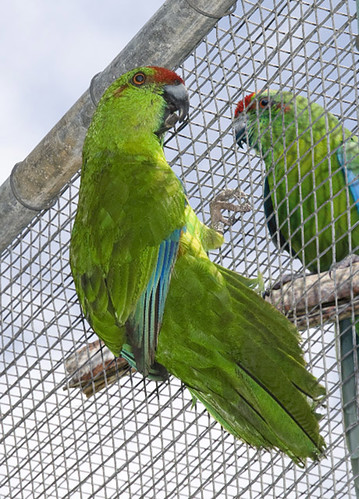 Romeo visiting Juliet before Juliet's release on May 8 2009Two love-struck green parrots are soon to be united when Norfolk Island National Park and Botanic Garden releases its last captive green parrots into the wild.
Romeo visiting Juliet before Juliet's release on May 8 2009Two love-struck green parrots are soon to be united when Norfolk Island National Park and Botanic Garden releases its last captive green parrots into the wild.
The release marks the end of the green parrot captive breeding program, and opens the door to the courtship of 'Juliet', a captive female parrot, and 'Romeo', a wild male parrot.
For the past few years, Romeo has been regularly visiting Juliet and feeding and courting her through the aviary wire. But they have never been able to fly together.
The green parrot is an endangered species found only on Norfolk Island. In 1983, the numbers of green parrots had dwindled to fewer than 30, with only four known pairs of breeding birds. Today there are some 200 green parrots in the wild - a great conservation success story for an endangered species.
Norfolk Island National Park Manager, Dr Coral Rowston, said this remarkable recovery is largely due to the assisted wild breeding program.
"Artificial tree hollows specially designed for green parrots have been constructed within the national park", she said.
"Each year at breeding season, park rangers stock nests with local nesting material and make sure predators and competitors such as rodents, cats and starlings are managed.
"The wild-breeding program has been a huge success. Some years we've had around 30 new chicks born into the population."
Captive breeding of green parrots has been less successful, with only a few chicks born during the 26 years of the program.
"We want to harness any remaining breeding potential of the last three captive parrots and think that their best chance is in the wild as part of the assisted wild breeding program.
"We know that captive-bred parrots are more likely to do well in the wild if they are supported by wild birds - so the relationship between Romeo and Juliet looks promising for a successful release and hopefully successful breeding," Dr Rowston said.
The aviary doors will be opened on Friday 8 May, so that Juliet and her two captive male friends can try life in the wild.
Park rangers will continue supporting the recovery of the green parrot across Norfolk Island by providing more nesting sites, managing their bushland habitat and controlling pest animals.